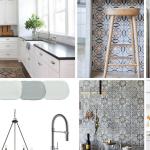
Preparing for a new home colour and fixture appointment.
By HOUSPECT Building and Pest Inspections|February 06, 2019
When you are choosing exterior materials for your home, preparing for a new colour and fixture appointment is the first logical step. You are going to discuss your vision for the build or renovation with experts but what you want is still the most important part of the process. After all, this is the home you plan to live in or sell on at a profit.
There are so many options to choose from that it’s easy to become overwhelmed or feel like you are being indecisive. When you have brick, block, stone, timber and so many other materials spinning around in your head it makes sense to take a step back and consider what you are bringing to your colour and fixture appointment.
Bring your Inspiration
Creating a portfolio of your wants is a great starting point. Look to the places that inspire your choices, whether that means sample magazines or the Pinterest boards you have been browsing for ideas. Organize your portfolio in a way that is easiest for you to quickly reference. A colour consultant will typically take your through features according to a design process which involves discussing roofing and gutters, garages, cladding, rendering and landscaping etc
The professionals are there to assist you in making choices that work so take the opportunity to bounce/ flesh out any key ideas you may have for your home. There are so many different shades and textures available in modern building materials so don’t rule anything out. If you are unable to find a picture that represents your vision, sketch it out with a rough description for discussion with your consultant.
Outline your Project
You may know exactly what you want to create but that doesn’t mean it is easily conveyed in words – especially when trying to explain to someone you have just met. Creating an outline of your project; including the “whys,” “whats” and “wheres” will help you articulate exactly what you want from the colour and fixture consultant. It will also save a lot of back and forth discussion, trying to ensure that both parties are on the same page.
You don’t have to be a professional artist to create a visual representation of your project. Sketches that are roughly to scale and show the position of fixtures and approximate colours you want will help you paint a picture. You can also include a key to link elements from your sketch to pictures from the portfolio of ideas you have created.
Consider Compromise
You may have to compromise on some of your ideas if they are unworkable, impractical or likely to leave your home looking less than aesthetically pleasing. That is not to say that you should abandon your vision altogether at the first hurdle. Listen to advice from your colour consultant before making a final decision on the palette for any area or room. Assuming you have hired a reliable company, an expert opinion is part and parcel of the service.
Try to find a number of different colours and shades for each of your design elements. This will allow you to present your ideas from different angles and give the colour consultant more to work with when it comes to providing professional advice. With that said, the final decision is ultimately yours and you are under no obligation to accept every suggestion without further discussion.
Once you have presented your ideas and the consultant has provided feedback and guidance, it is time to agree on materials and colour schemes. Finally, make sure that you only sign off on finalised plans and not any rough drafts which were created during the consultation.
There are so many options to choose from that it’s easy to become overwhelmed or feel like you are being indecisive. When you have brick, block, stone, timber and so many other materials spinning around in your head it makes sense to take a step back and consider what you are bringing to your colour and fixture appointment.
Bring your Inspiration
Creating a portfolio of your wants is a great starting point. Look to the places that inspire your choices, whether that means sample magazines or the Pinterest boards you have been browsing for ideas. Organize your portfolio in a way that is easiest for you to quickly reference. A colour consultant will typically take your through features according to a design process which involves discussing roofing and gutters, garages, cladding, rendering and landscaping etc
The professionals are there to assist you in making choices that work so take the opportunity to bounce/ flesh out any key ideas you may have for your home. There are so many different shades and textures available in modern building materials so don’t rule anything out. If you are unable to find a picture that represents your vision, sketch it out with a rough description for discussion with your consultant.
Outline your Project
You may know exactly what you want to create but that doesn’t mean it is easily conveyed in words – especially when trying to explain to someone you have just met. Creating an outline of your project; including the “whys,” “whats” and “wheres” will help you articulate exactly what you want from the colour and fixture consultant. It will also save a lot of back and forth discussion, trying to ensure that both parties are on the same page.
You don’t have to be a professional artist to create a visual representation of your project. Sketches that are roughly to scale and show the position of fixtures and approximate colours you want will help you paint a picture. You can also include a key to link elements from your sketch to pictures from the portfolio of ideas you have created.
Consider Compromise
You may have to compromise on some of your ideas if they are unworkable, impractical or likely to leave your home looking less than aesthetically pleasing. That is not to say that you should abandon your vision altogether at the first hurdle. Listen to advice from your colour consultant before making a final decision on the palette for any area or room. Assuming you have hired a reliable company, an expert opinion is part and parcel of the service.
Try to find a number of different colours and shades for each of your design elements. This will allow you to present your ideas from different angles and give the colour consultant more to work with when it comes to providing professional advice. With that said, the final decision is ultimately yours and you are under no obligation to accept every suggestion without further discussion.
Once you have presented your ideas and the consultant has provided feedback and guidance, it is time to agree on materials and colour schemes. Finally, make sure that you only sign off on finalised plans and not any rough drafts which were created during the consultation.



